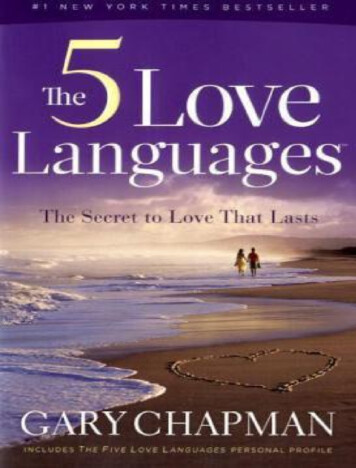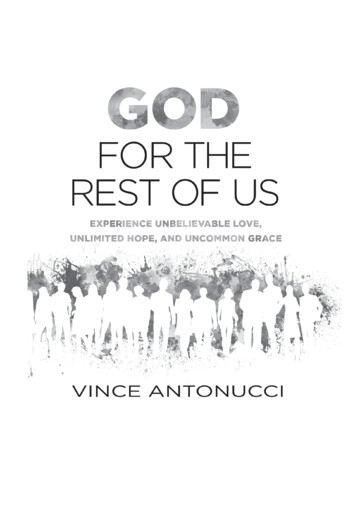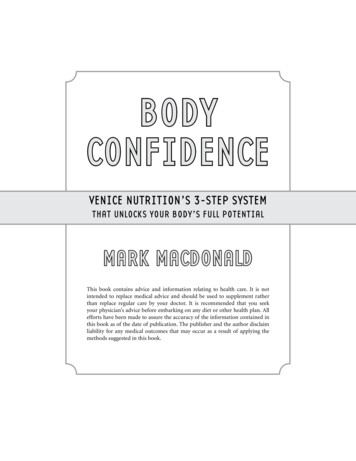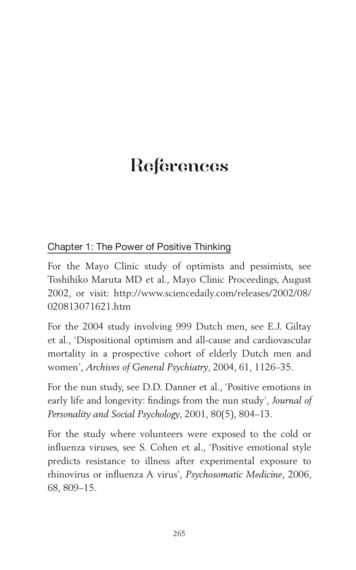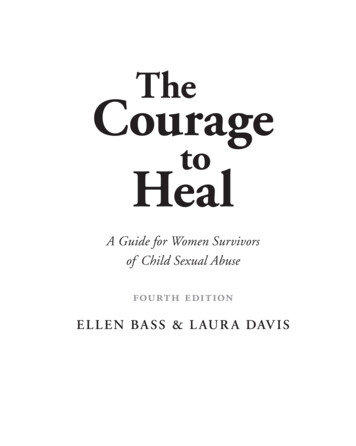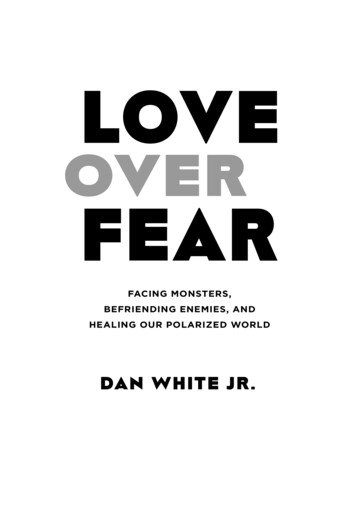
Transcription
LOVEOVERFEARFACING MONSTERS,BEFRIENDING ENEMIES, ANDHEALING OUR POLARIZED WORLDDAN WHITE JR.
Chapter 1THE WAYFEAR WORKSYour relationship with fear is the most important onein your life because it’s also a mirror of the relationshipyou have in your core. k r isten Ulmer
PREFRON TALCORTE GYgMnAr, At”“Fea itemenExcINA MRB T E ingS athre & f”ufSt“BRCEEBLELUM
Re f l e c t i o n Q u e s t i o n s1. What is the big idea that sticks out to you in this chapter?2. What part of “how fear works” brings you some conflictor clarity in your life?3. What practical step can you take to unplug from theculture of fear in and around your life?
Chapter 2LOVE ANDFEAR AT WAROnce a person learns to read the signs of love and thus tobelieve it, love leads him into the open field wherein hehimself can love. hans U rs von balthasa r
�US”?Can you see the image of God in abortion doctors?Can you see the image of God in the LGBTQcommunity?
Re f l e c t i o n Q u e s t i o n s1. What big idea about God’s love lifts to the surface for youin this chapter?2. What part of this love makes you feel uncomfortable or abit conflicted?3. What practical step can you take to embrace this perfectlove in your life?
Chapter 3HOW FEARPOLARIZES USThe process of categorisation is as old as man . . . no otheranimal species categorises itself so neatly. . . . [Yet it] is aprocess that destroys the very empathy that traditionallybinds diverse communities together. JoshUa k rook
MONSTERATTACKAVOID
Re f l e c t i o n Q u e s t i o n s1. What about the concept of polarization is new to you inthis chapter?2. What part of “false choices” makes you feel some conflictor confusion?3. What practical step can you take to move beyond either/or ways of relating with others?
Chapter 4AFFECTIONFOR MONSTERSMen think that it is impossible for a human beingto love his enemies, for enemies are hardly able toendure the sight of one another. Well, then, shut youreyes—and your enemy looks just like your neighbor. sØr en kierk ega a r D
Source: Jacob van Maerlant, Der Naturen Bloeme,Flanders, ca. 1350. Wikimedia Commons.Public domain.
MONSTERAFFECTIONATTACKAVOID
Re f l e c t i o n Q u e s t i o n s1. What part of the passage on loving enemies is most scandalous to you?2. What part of affection for monsters brings you someconflict or clarity in your own life?3. What step can you take to close the void between you andothers in the “them” category?
Chapter 5WHEN LOVECOMES TO TOWNThe search for truth is not an effort to apprehendfacts but rather the faithful work to truly see people. e sther m eeks
ECUNBOWORDSBACKFIRING
VELODESNDESCCLIMBTHE DARK
Re f l e c t i o n Q u e s t i o n s1. What part of “knowing through relational presence” isinteresting to you? Why?2. What part of “kenosis to love enemies” brings you someconflict or clarity in your life?3. What step can you take to face the monster withinyourself?
Chapter 6BREAKINGOPEN SPACEJudging others makes us blind, whereas love is illuminating. By judging others we blind ourselves to our own eviland to the grace which others are just as entitled to as weare. Diet r ich bonhoeFFer
Re f l e c t i o n Q u e s t i o n s1. What part of Law Culture vs. Relational Culture is significant to you?2. Do you find yourself being “judgy”? How so?3. What step can you take to break open space in a polarizedsituation?
Chapter 7MAKING MEALSFOR FRENEMIESThe stranger at the door is the living symbol . . . that weare all strangers here. . . . We were pilgrims and wanderers. . . even enemies of God, but we, too, were welcomed intothis place. thom as g . long
BEHOLDINGOTHERSBEARINGWITNESS
Re f l e c t i o n Q u e s t i o n s1. What part about Jesus eating and drinking with others issignificant for you?2. What part of meals being “political” brings you conflict orconfusion?3. What practical step can you take to center the table in yourlife?
Chapter 8COMPASSIONATECURIOSITYListening is much more than allowing another to talkwhile waiting for a chance to respond. Listening is payingfull attention to others and welcoming them into our verybeings. hen r i noU W en
BE INDISTINCTBE INTERPERSONALBE INQUISITIVEBE INTERESTEDCOMPASSIONATECURIOSITY PATH
Re f l e c t i o n Q u e s t i o n s1. We all suffer. How does this change our postures towardeach other?2. What part of “asking questions” is difficult for you?3. What practical step can you take to move along the Curiosity Path?
Chapter 9THE AIKIDO OFFORGIVENESSHatred tends to dry up the springs of creative thought inthe life of the hater, so that his resourcefulness becomescompletely focused on the negative aspects of hisenvironment. hoWa r D thU r m an
Re f l e c t i o n Q u e s t i o n s1. How does the act of forgiveness shift the power betweenpeople?2. How do you know when it’s time to just heap hot coals onsomeone’s head?3. What practical step can you take to practice the aikido offorgiveness with someone?
NOTESChapter 1: The Way Fear Works1. Robin L. Snipes, Michael S. LaTour, and Sara J. Bliss, “A Model of theEffects of Self-efficacy on the Perceived Ethicality and Performance ofFear Appeals in Advertising,” Journal of Business Ethics 19 (April 1999)273–85.2. “FDA 2016 Decision and History,” Beyond Pesticides, erials/triclosan/fda-2016decision-and-history.3. Kristen Ulmer, The Art of Fear: Why Conquering Fear Won’t Workand What to Do Instead (New York: Harper Wave, 2017), 34–36.4. Tom Pyszczynski, “What Are We So Afraid Of?: A Terror Management Theory Perspective on the Politics of Fear,” Social Research: AnInternational Quarterly 71, no. 4 (Winter 2004).5. Shanto Iyengar and Sean J. Westwood, “Fear and Loathing acrossParty Lines: New Evidence on Group Polarization,” Journal of PoliticalScience 59 (2015): 690–707.6. Pyszczynski, “What Are We So Afraid Of?”7. Politico Staff, “Full text: Donald Trump 2016 RNC draft speechtranscript,” July 21, 2016, Politico, nc-225974.8. Quoted in Mark Leibovich, “‘I’m the Last Thing Standing Between Youand the Apocalypse,’ ” The New York Times, October 16, 2016, y-clinton-campaignfinal-weeks.html.9. Kristen Ulmer, The Art of Fear: Why Conquering Fear Won’t Workand What to Do Instead (New York: Harper Wave, 2017), 34–36.10. Dan White Jr., “The Psychological Junk-Food: Cynicism,” Dan WhiteJr. (blog), March 19, 2012, al-junk-food-cynicism.html.11. Ronald Rolheiser, Forgotten Among the Lilies (New York: DoubleDay, 2003), 112–13.
12. Ibid.13. Ibid.14. Sendhil Mullainathan, Scarcity: The Science of Having Less and How ItDefines Our Lives (London: Picador, 2014), 56–58.15. Robb Rutledge, “A Computational and Neural Model of Happiness,”Robb Rutledge (website), August 8, 2014,. tational-and-neural-model-of-happiness.16. Mullainathan, Scarcity, 56–58.17. Dan White Jr., Subterranean: Why the Future of the Church is Rootedness (Eugene, OR: Cascade Books, 2015), 95.18. Sasha Abramsky, Jumping at Shadows: The Triumph of Fear andthe End of the American Dream (New York: Nation Books, 2017),109–110.19. Ibid.20. Joshua Greene, Moral Tribes: Emotion, Reason, and the Gap betweenUs and Them (London, England: Penguin Publishing, 2013), 46–48.21. Gregory Boyd, Repenting of Religion: Turning From Judgment to theLove of God (Ada, MI: Baker Books, 2004), 74–75.Chapter 2: Love and Fear at War1. Star Wars: Episode I – The Phantom Menace, directed by GeorgeLucas (San Francisco: Lucasfilm, 1999).2. David G. Benner, Surrender to Love: Discovering the Heart of Christian Spirituality (Downers Grove, IL: IVP Books, 2003), 22–23.3. Ibid.4. Doug Frank, A Gentler God: Breaking Free of the Almighty in theCompany of the Human Jesus (Menangle, Australia: Albatross, 2010),133–34.5. Anthony W. Bartlett, Seven Stories: How to Study and Teach theNonviolent Bible (Syracuse, NY: Hopetime Press, 2017), 46–48.6. Stuart Murray, The Naked Anabaptist: The Bare Essential of a RadicalFaith (Scottdale, PA: Herald Press, 2010), 88–90.7. Hans Urs Von Balthassar, Love Alone is Credible (San Francisco:Ignatius Press, 1963), 91–92.8. Ibid.9. Karl Barth, The Doctrine of God: Church Dogmatics, Vol. 2, Part 1(Edinburgh, Scotland: T&T Clark, 1957), 157–59.10. Lee C. Camp, Mere Discipleship: Radical Christianity in a RebelliousWorld (Grand Rapids: Brazos Press, 2003), 26–27.11. Bede’s Ecclesiastical History of the English People, ed. Bertram Colgrave and R. A. B. Mynors. (Oxford: Clarendon Press, 1968), 150–51.
NOTES12. Von Balthassar, Love Alone Is Credible, 92–93.13. Mike Bennett, “Fear of the Lord: What Does It Mean?,” Life, Hope& Truth, f-thelord/.14. Brennan Manning, Abba’s Child: The Cry of the Heart for IntimateBelonging (Colorado Springs: NavPress, 2002), 20.15. Søren Kierkegaard, Fear and Trembling (1843; repr., London: PenguinBooks, 1985), 52–53.16. Reuven Hammer, The Classic Midrash: Tannaitic Commentaries onthe Bible (Mahwah, NJ: Pualist, 1995), 190–91.17. Ibid.18. Scot McKnight, Embracing Grace: A Gospel for All of Us (Orleans,MA: Paraclete Press, 2012), 42–43.19. Robin Dunbar, Grooming, Gossip, and the Evolution of Language(Cambridge, MA: Harvard University Press, 1998), 132–33.20. Anthony W. Bartlett, Seven Stories: How to Study and Teach theNonviolent Bible (Syracuse, NY: Hopetime Press, 2017), 62–64.Chapter 3: How Fear Polarizes Us1. Basing this off the traditional fight-or-flight response (also called acutestress response) is a physiological reaction that occurs in response toa perceived harmful event to survival. It was first described by WalterBradford Cannon in his book The Wisdom of the Body, 1932.2. Michael J. Gorman, Reading Revelation Responsibly: Uncivil Worshipand Witness: Following the Lamb into the New Creation (Eugene, OR:Wipf & Stock, 2011), 78–81.3. Ibid.4. Tim Gombis, “Describing Passive-Aggressive Relational Postures,”Faith Improvised (blog), August 3, 2012, e-aggressive-relational-postures.5. Ibid.6. Thank you Giles Sieburg (clinical therapist) for our conversations onneurology and trauma.7. Dan White Jr., “When Clinton and Bush Go to Church . . .Together,”V3, January 23, 2017, ush-go-to-church/.8. Walter Wink, Engaging the Powers: Discernment and Resistance in aWorld of Domination (Minneapolis: Fortress, 1992), 95–98.9. Joshua Greene, Moral Tribes: Emotion, Reason, and the Gap BetweenUs and Them (London, England: Penguin Publishing, 2013), 112–14.10. Ibid.
11. Robin Dunbar, The Science of Love (New York: Wiley, 2012), 92–93.12. Jonathan Haidt, The Righteous Mind: Why Good People Are Dividedby Politics and Religion (New York: Random House, 2012), 145–46.13. Carl Jung, The Development of Personality, The Collected Worksof C. G. Jung, vol. 17 (Princeton: Princeton University Press, 1954),135–36.14. Ibid.15. Wil Hernandez, Henri Nouwen and Spiritual Polarities: A Life ofTension (Mahwah, NJ: Paulist Press, 2012), 85–87.16. “False Dilemma Examples,” SoftSchools.com, e dilemma examples/491/.17. Ibid.18. Ibid.19. “Logical Fallacies,” Flashcards, Quizlet, sh-cards/.20. Carl Jung, The Structure and Dynamics of the Psyche, The CollectedWorks of C. G. Jung, vol. 8 (Princeton: Princeton University Press,1960) 133–134.21. David Ropeik, “How Tribalism Overrules Reason, and Makes RiskyTimes More Dangerous,” Big Think, May 14, 2012, -dangerous.22. Shaye J.D. Cohen, Paula Fredriksen, and L. Michael White, “Judaism’sFirst Century Diversity,” PBS, April 1998, s/religion/portrait/judaism.html.23. Josephus Flavius, The Works of Josephus: Complete and Unabridged,New Updated Edition (Peabody, MA: Hendrickson, 1980), 235–39.24. Cohen, Fredriksen, and White, “Judaism’s First Century Diversity.”25. Flavius, The Works of Josephus, 235–39.26. Ibid.27. Josephus Flavius, The Jewish War (Peabody, MA: Hendrickson, 1980),201–203. Many first-century historians believe Judas’s surname Iscariotwas a corruption of the Latin sicarius (“murderer” or “assassin”) ratherthan an indication of family origin; Josephus establishes that Sicarii wasa radical Jewish group, some of whom were terrorists. This has becomea commonly held sociohistorical belief in the last fifteen years or so.28. Matthew Murray, The Sons of Zebedee: A Biography of the ApostleJames and John (Buchanan, NY: BookCaps, 2013), 45–52.29. Joe Iovino, “Living As a Person of Peace in a Broken World,” UMC.org, son-ofpeace-in-a-broken-world.
NOTESChapter 4: Affection for Monsters1. Damien Kempf and Maria Gilbert, Medieval Monsters (London: British Library, 2015), 135–39.2. Ibid.3. Jean Vanier and Stanley Hauerwas, Living Gently in a Violent World:The Prophetic Witness of Weakness (Downers Grove, IL: IVP Books,2018), 62–63.4. E. Stanley Jones, The Unshakable Kingdom and the UnchangingPerson (New York: McNett Press, 1995), 135–36.5. Tim Suttle, “Stanley Hauerwas: A Prayer for Our Enemies As We AreAll Learning How to Hate,” October 19, 2017, html.6. Ibid.7. Wayne Gordon, Who Is My Neighbor?: Lessons Learned from a ManLeft for Dead (Ventura, CA: Gospel Light, 2010), 133–34.8. Ibid.9. Wendell Berry, It All Turns on Affection: The Jefferson Lecture andOther Essays (Berkeley, CA: Counterpoint Press, 2012).10. Tim Suttle, “Stanley Hauerwas: A Prayer for Our Enemies as We AreAll Learning How to Hate,” October 19, 2017, html.11. David Benjamin Blower, Sympathy for Jonah: Reflections on Humiliation, Terror and the Politics of Enemy-Love (Eugene, OR: Wipf &Stock, 2014), 44–48.12. Ibid.13. Ibid.14. Sara H. Konrath, Edward H. O’Brien, and Courtney Hsing, “Changesin Dispositional Empathy in American College Students Over Time:A Meta-Analysis,” Personality and Social Psychology Review 15, no. 2(2010).15. Ibid.16. Phyllis Tickle, The Great Emergence: How Christianity Is Changingand Why (Grand Rapids: Baker Books, 2008), 115–16.17. Janna Anderson and Lee Rainie,”The Future of Well-Being in aTech-Saturated World,” Pew Research Center, 018 survey/Elon Pew DigitalLife and Well Being Report 2018 Expanded Version.pdf;“Political Polarization in the American Public,” Pew ResearchCenter, June 12, 2014, http://www.people-press.org/2014/06/12/
political-polarization-in-the-american-public/; Dan White Jr., “WhenClinton and Bush Go to Church . . . Together,” V3, January 23, 2017,http://thev3movement.org/2017/01/when- clinton-and-bush-go-tochurch/.18. “U.S. Adults Have Few Friends—and They’re Mostly Alike,” BarnaTrends 2018, October 23, 2018, .19. Mallory Simon and Sara Sidner, “What Happened When a KlansmanMet a Black Man in Charlottesville,” CNN, updated December 16,2017, klansmanblack-man-meeting/index.html. “How One Man Convinced 200 KuKlux Klan Members to Give Up Their Robes,” All Things Considered,August 20, 2017, eirrobes.20. Simon and Sidner, “What Happened When a Klansman Met a BlackMan in Charlottesville.”21. Ibid.22. Ibid.23. Martin Luther King Jr., “An Address by the Reverend Dr. MartinLuther King, Jr.” (speech, Cornell College, Mount Vernon, Iowa,October 15, 1962), Cornell College, ings-visit-to-cornell-college/.24. Richard Beck, Unclean: Meditations on Purity, Hospitality, andMortality (Eugene, OR: Cascade Books, 2011), 77–79.Chapter 5: When Love Comes to Town1. David Benjamin Blower, Sympathy for Jonah: Reflections on Humiliation, Terror and the Politics of Enemy-Love (Eugene, OR: Wipf &Stock, 2014), 95–98.2. Lorraine Devon Wilke, “Deconstructing the Expert Delusion: No,Not Everyone Is One,” Huffington Post, December 6, 2017, e/deconstructing-theexpert-delusion b 4735182.html.3. Peter Senge, The Fifth Discipline: The Art and Practice of Learning(New York: Random House, 1999), 35–39.4. René Descartes, Descartes: The Essential Collection (New York: TitanRead, 2014), 144–46.5. Ibid.6. P. J. Manney, “Is Technology Destroying Empathy?,” Live Science,June 30, 2015, umanity-together-or-tear-it-apart.html.
NOTES7. Joseph Burgo, The Narcissist You Know: Defending Yourself AgainstExtreme Narcissists (New York: Touchstone, 2015), 122–23.8. Michela Del Vicario et al., “The Spreading of Misinformation Online,”Proceedings of the National Academy of Sciences 113, no. 3 (January 2016).9. Ann Jervis, Paul: Ethics in the Ancient Mediterranean World (Princeton,NJ: Princeton University, 2001), 35–39.10. Homer, Iliad (Book I), eNotes, . Esther Lightcap Meek, Loving to Know: Covenant Epistemology(Eugene, OR: Wipf & Stock, 2011), 205–207.12. Ibid.13. Sasha Abramsky, Jumping at Shadows: The Triumph of Fear and theEnd of the American Dream (New York: Nation Books, 2017), 25–28.14. Michael Shermer, “How to Convince Someone When Facts Fail,”Scientific American, January 1, 2017, convince-someone-when-facts-fail/.15. Brendan Nyhan and Jason Reifler. “When Corrections Fail: ThePersistence of Political Misperceptions,” Political Behavior 32, no. 2(June 2010).16. Ibid.17. Marnie Eisenstadt,”Friendship Formed in Disagreement: One WantsBetter Gun Control, One Supports the NRA,” Syracuse.com, April 6,2018, a friendship forged in disagreement one wants better gun control onesupports th.html.18. Ibid.19. Marcus Peter Rempel, Life at the End of Us Vs. Them: Cross CulturalStories (Victoria, BC: Friesen Press, 2017) 120–123.20. David Benjamin Blower, Sympathy for Jonah: Reflections on Humiliation, Terror and the Politics of Enemy-Love (Eugene, OR: Wipf &Stock, 2014) 65–67.21. “The Four Loves,” Wikipedia, last edited November 18, 2018, https://en.wikipedia.org/wiki/The Four Loves.22. Richard Rohr, The Art of Letting Go: Living the Wisdom of SaintFrancis. . Richard Beck, Unclean: Meditations on Purity, Hospitality, andMortality (Eugene, OR: Cascade Books, 2011) 115–116.24. Ibid.25. David Benjamin Blower, Sympathy for Jonah, 67–69.26. Kallistos Ware, The Orthodox Way, rev. ed. (Crestwood, NY: StVladimir’s Seminary Press, 1995), 69–72.
27. John Howard Yoder, The Politics of Jesus (Grand Rapids: Eerdmans,1994), 90–92.Chapter 6: Breaking Open Space1. David Fitch, “Neither Do I Condemn Thee: Making Space forAlternative Sexualities in Our Midst,” Missio Alliance, November 10,2015, e-makingspace-alternative-sexualities-midst/.2. “Mens Rea,” Legal Information Institute, https://www.law.cornell.edu/wex/mens rea.3. “Chapter 8– The Federal Courts: The Judicial Branch,” Flashcards,Quizlet, l-courtsthe-judicial-branch-flash-cards/.4. Gayle Olson-Raymer, “The Role of the Federal Government in Juvenile Delinquency Prevention: Historical and Contemporary Perspectives,” Journal of Criminal Law and Criminology 74, no. 2 (Summer1983).5. Dietrich Bonhoeffer, Ethics, trans. N. H. Smith (New York: Simon &Schuster, 1949) 111–14.6. Robert V. Wolf, “Highlights of a Roundtable Discussion among Tribaland State Leaders,” Center for Court Innovation, /documents/PeacemakingToday.pdf.7. Ibid.8. Tadodaho Sid Hill, “Tadodaho Sid Hill speaks with Renee K. Gadoua,” YouTube, https://www.youtube.com/watch?v 4NaX0lA3S50.I learned many of these principles from Onondaga Nations leaderTadodaho Sid Hill.9. David E. Garland, “The Dispute Over Food Sacrificed to Idols,”https://www.vanderbilt.edu/AnS/religious studies/SNTS2002/garland.htm.10. Ibid.11. Ibid.12. N. T. Wright, 1 Corinthians: N.T. Wright for Everyone Bible StudyGuides (London: SPCK Publishing, 2003), 165–67.13. Dietrich Bonhoeffer, Ethics, trans. N. H. Smith (New York: Simon &Schuster, 1949), 112–14.14. Peter Kreeft, Knowing the Truth of God’s Love: The One Thing WeCan’t Live Without (Ann Arbor, MI: Servant Press, 1988), 84–86.15. Larry Crabb, Connecting: Healing for Ourselves and Our Relationships (Nashville: Word, 1997), 75–76.16. Ibid.17. Fitch, “Neither Do I Condemn Thee.”
NOTES18. Ibid.19. Thank you Terri Pease from The Park Church San Antonio for sharingthis story with me.Chapter 7: Making Meals for Frenemies1. Michael J. McVicar, “The Religious Right in America,” OxfordResearch Encyclopedias, 7.2. Jim Wallis, “The New Evangelical Leaders, Part I,” interview by KristaTippett, On Being with Krista Tippett, November 29, 2007, angelical-leaders-part-i/.3. Jedediah Purdy, “North Carolina’s Long Moral March and Its Lessonsfor the Trump Resistance,” The New Yorker, February 17, e-trump-resistance.4. Marcus Peter Rempel, Life at the End of Us vs. Them: Cross CulturalStories (Victoria, BC: FriesenPress, 2017), 130–32.5. CT Editors, “What Tim Keller Wants American Christians to Knowabout Politics,” Christianity Today, October 3, 2018, tates.html.6. Mark Glanville, “Jesus Ate His Way through the Gospels .,” WestvillePresby Presbyterian Church, July 28, 2017, -ate-his-way-through-the-gospels/.7. Jan Michael Joncas, “Tasting the Reign of God: The Meal Ministry ofJesus and Its Implications for Christian Worship and Life” (HabigerLecture, St. Paul, MN, April 10, 2000), 114–17.8. Ibid.9. Ibid.10. “The Revolutionary Table of Jesus,” Lutheran Campus Ministry inBaltimore, September 2, 2013, sus.11. Lisa Hickman, “Eating with the Enemy: Esther’s Story,” HuffPost,September 26, 2012, updated December 6, 2017, -with-the-enemy-est b 1916776.html.12. Ibid.13. Marva J. Dawn, Powers, Weakness, and the Tabernacling of God(Grand Rapids: Eerdmans, 2001), 94–97.14. C. S. Lewis, The Weight of Glory (San Francisco, CA: HarperOne,1977), 122–23.
15. Leanne Payne, Real Presence: The Glory of Christ With Us and WithinUs (Grand Rapids: Baker Books, 1979), 114–16.16. Greg Paul, God in the Alley: Being and Seeing Jesus in a Broken World(Colorado Springs: Watebrook Press, 2004), 74–75.17. John Howard Yoder, The Politics of Jesus (Grand Rapids: Eerdmans,1994), 111–13.18. Jon Huckins and Rob Yackley, Thin Places: 6 Postures for Creating andPracticing Missional Community (Kansas City, MO: The House Studio,2012), 74–77.19. Susha Roberts, “10 Lessons from Jesus’ Table,” Wycliffe, us-table.20. Marnie Eisenstadt, “He Once Ate Out of Garbage Cans and SoldDrugs, Now He’s Feeding Syracuse’s Homeless,” December 11, 2017,updated July 20, 2018, he once ate out of garbage cans and sold drugsnow hes feeding syracuses homeles.html.21. Ibid.22. Aaron Chambers, Eats with Sinner: Loving Like Jesus (ColoradoSprings: NavPress, 2009), 41–43.Chapter 8: Compassionate Curiosity1. Abraham Cohen, Everyman’s Talmud: The Major Teachings of theRabbinic Sages (New York: BN Publishing, 2008), 84–86.2. William Packer, Narratives of a Vulnerable God (London, England:John Knox, 1994), 64–66.3. Mario Livio, Why?: What Makes Us Curious (New York: Simon &Schuster, 2017), 111–12.4. Ibid.5. Ibid.6. Adrian F. Ward, “The Neuroscience of Everybody’s Favorite Topic,”Scientific American, July 16, 2013, . Scot McKnight, A Fellowship of Differents: Showing the World God’sDesign for Life Together (Grand Rapids: Zondervan, 2015), 44–47.8. Vicky Hartley, “The Secret to Being Present in a Conversation,”Watkins, September 26, 2016, ing-present-in-a-conversation/.9. Brian D. McLaren, The Secret Message of Jesus (Nashville: ThomasNelson, 2006), 113–14.10. Slavoj Zizek, The Sublime Object of Ideology (Brooklyn, NY: VersoPress, 2009), 89–92.
NOTES11. Peter Block, Community: The Structure of Belonging (San Francisco:Berret-Koehler, 2008), 120–22.Chapter 9: The Aikido of Forgiveness1. Sarah Lewis, The Rise: Creativity, the Gift of Failure, and the Searchfor Mastery (New York: Simon & Schuster, 2015), 70–73.2. Ibid.3. Wendy Palmer, The Practice of Freedom: Aikido Principles as aSpiritual Guide and The Intuitive Body (Boulder, CO: Rodmell Press,2010), 34–35.4. Ibid.5. Ibid.6. Stanley Hauerwas, Matthew, Brazos Theological Commentary on theBible (Grand Rapids: Brazos, 2006), 67–68.7. Glen H. Stassen, Living the Sermon on the Mount (San Francisco:Jossey-Bass, 2006), 82–84.8. Ibid.9. Ibid.10. Josephus Flavius, The Works of Josephus: Complete and Unabridged,New Updated Edition (Peabody, MA: Hendrickson Pub, 1980), 222–23.11. Hauerwas, Matthew, 132–33.12. Christopher Kaczor, The Gospel of Happiness: Rediscovery YourFaith through Spiritual Practices (New York: Crown Publishing, 2015),71–72.13. Ibid.14. Joan O’C Hamilton, “Peace Work,” Stanford Magazine, May/June2001, https://stanfordmag.org/contents/peace-work.15. Fred Luskin, quoted in ibid.16. Howard Thurman, Jesus and the Disinherited (Nashville: AbingtonPress, 1949), 90–91.17. See Kaczor, The Gospel of Happiness, 71–72.18. Brad Jersak, “The So-Called ‘Violence’ of Jesus in the So-Called‘Cleansing of the Temple,’” Clarion: Journal of Spirituality and Justice,June 17, 2013, http://www.clarion-journal.com/clarion journalof k.html.19. Ibid.20. Matt McKinney, “Indianapolis Church Locks Up Mary, Joseph, BabyJesus to Condemn Immigration Policy,” The Indy Channel, July 3,2018, https://www.theindychannel.com/news/local-news/
eph-baby-jesusto-condemn-immigration-policy.21. Zachary K. Rothschild and Lucas A. Keefer, “What Makes PeopleExpress Moral Outrage?,” The Guardian, April 3, 2017, /03/moral-outrage-publicanger-reasons.22. Brad J. Bushman, “Does Venting Anger Feed or Extinguish the Flame?Catharsis, Rumination, Distraction, Anger, and Aggressive Responding,” Personality and Social Psychology Bulletin 28, no. 6 (2002).23. Ibid.24. Ibid.
Star Wars: Episode I - The Phantom Menace, directed by George Lucas (San Francisco: Lucasfilm, 1999). 2. David G. Benner, Surrender to Love: Discovering the Heart of Chris - tian Spirituality (Downers Grove, IL: IVP Books, 2003), 22-23. 3. Ib di . 4. Doug Frank, A Gentler God: Breaking Free of the Almighty in the
